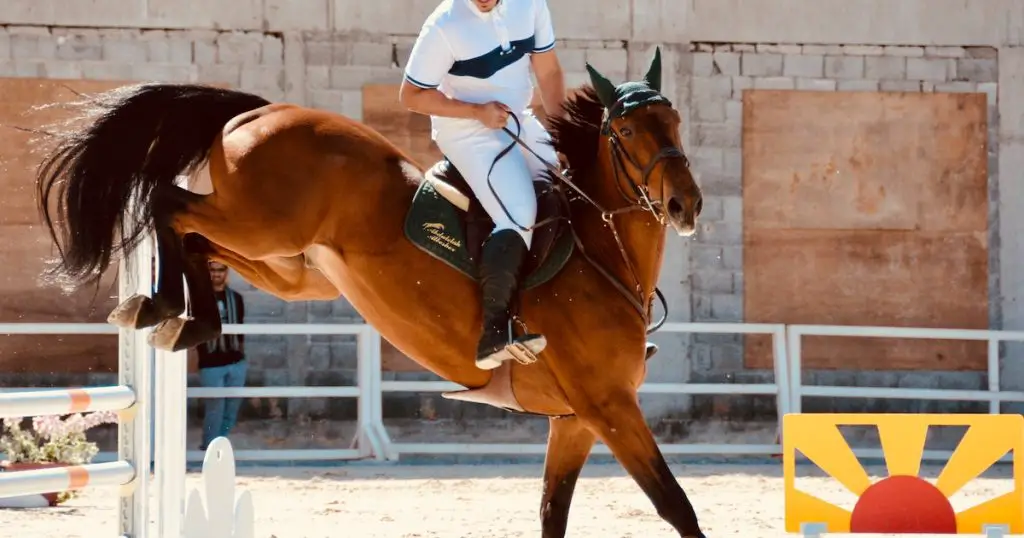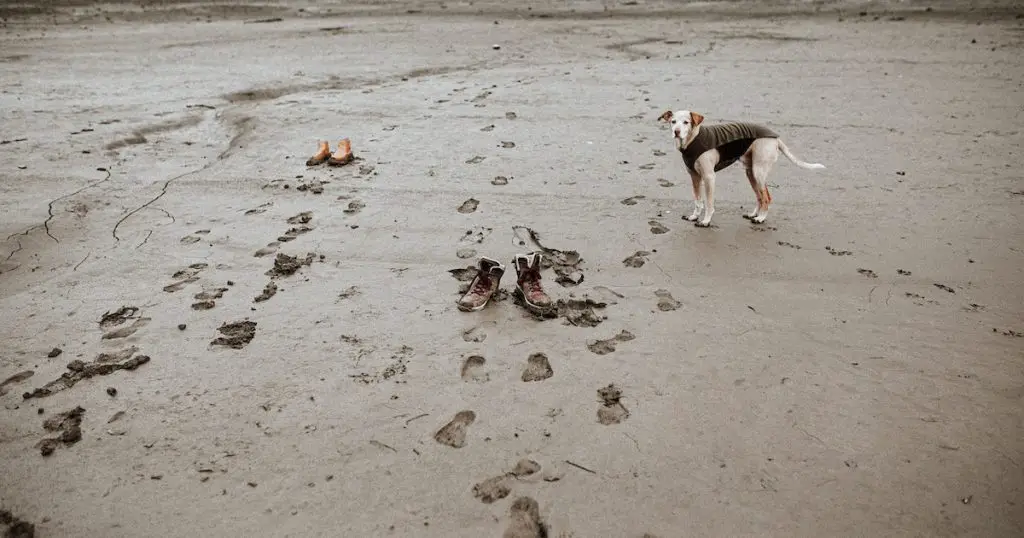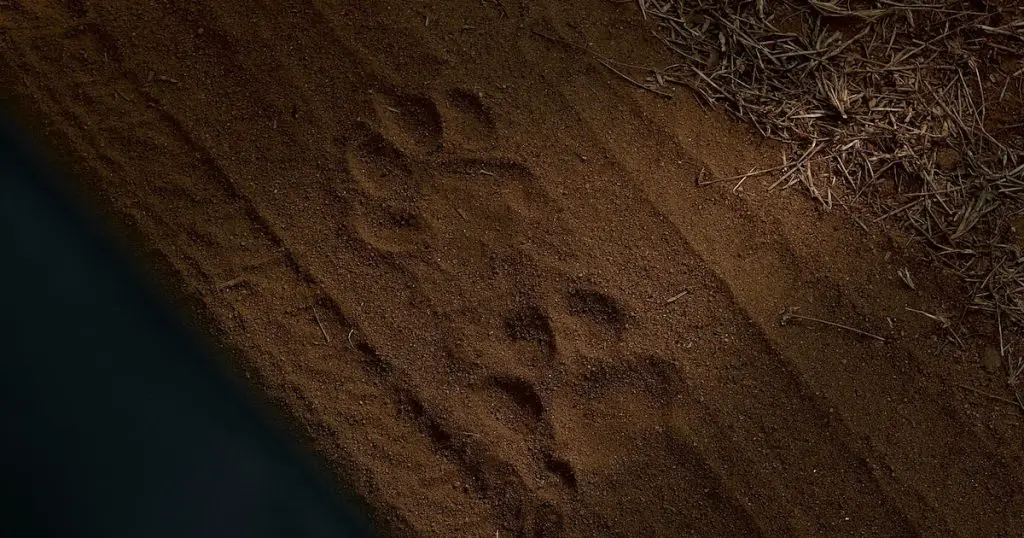Prescott is a treasure trove for wildlife enthusiasts. The joy of walking through Prescott’s natural terrains is often amplified when one stumbles upon intriguing animal footprints.

Tracking and identifying animal footprints in Prescott isn’t just an exciting hobby; it’s also an essential aspect of understanding the region’s rich biodiversity. In this comprehensive guide, we will embark on a journey to discover the art, science, and wonder of footprint identification.
Understanding Animal Footprints Basics
When you’re out in the wild or even in your backyard, every footprint tells a story. Understanding the basics of animal footprints is the first step in unraveling these stories.
Every footprint has unique characteristics that can provide hints about the animal it belongs to. These characteristics include the size, shape, number of toes, and the presence or absence of claws or nails. For example, the footprints of carnivores often show clear claw marks, while those of herbivores might not.
Additionally, the depth and pressure of the print can give insights into the animal’s weight and its speed during movement. Animal Diversity Web offers an excellent database on different animals, which can help correlate footprint anatomy with specific species.
Factors Influencing Footprint Appearance
The type of soil, whether it’s muddy, sandy, or rocky, plays a significant role in how a footprint appears. For instance, soft mud will capture a more detailed impression, while hard surfaces might only reveal partial prints. National Geographic has some amazing articles that delve deeper into how terrains can influence animal movement and behavior.
Animals behave differently based on their needs and surroundings. An animal on a leisurely stroll will leave a different set of footprints compared to one that’s running or hunting.
Rain, snow, and wind can all alter the appearance of footprints. While rain might make the soil ideal for capturing clear footprints, it can also wash them away if it’s too heavy.
The Tools of the Trade
For those delving into the art of tracking in Prescott, having the right tools can make all the difference. Modern trackers often equip themselves with field guides for footprint identification, magnifying glasses to discern the minutest details, and mold-making materials to capture and study unique tracks.
Additionally, a good quality camera is indispensable for documenting finds and sharing them with the broader tracking community. Digital tools, such as specialized apps, have also emerged, offering real-time assistance in footprint identification.
While technology has added a new dimension to the tracker’s toolkit, the age-old essentials of keen observation, patience, and respect for nature remain paramount.
Essential Tools for Tracking
Every tracker needs a good field guide that specifically caters to the region’s wildlife. Along with that, a measuring tape to measure the size and stride of footprints, and a journal or app to note down observations can be invaluable. A magnifying glass can help in closely examining the intricate details of a footprint.

- Field guide for Prescott’s wildlife
- Measuring tape
- Notebook or tracking app
- Magnifying glass
Websites like Tracker’s Earth provide a wealth of resources and tools tailored for budding and experienced trackers.
High-tech Tools for Modern Trackers
Modern technology offers digital tools like GPS devices to pinpoint exact locations of footprints, and apps that can help identify animal tracks.
Some trackers also use motion-activated cameras to capture animals in action, adding another dimension to their tracking adventures.
Preserving Footprints for Further Study
Once you’ve identified a footprint, you might want to preserve it. This can be done using plaster casts. Creating a plaster cast of a footprint can be an exciting activity and provides a tangible memory of your tracking adventures.
The Museum of Natural History has a detailed guide on how to make and preserve plaster casts of animal footprints.
Prescott’s Diverse Animal Inhabitants
Nestled within the heart of Arizona, Prescott stands as a sanctuary for a diverse array of animal inhabitants. From the chirping birds that grace its skies to the stealthy mammals that tread its grounds, the region is a vibrant tapestry of life.
The murmur of insects, the rustling of reptiles, and the distant calls of larger animals create an ever-evolving symphony. Each species, whether large or small, plays a unique role in shaping Prescott’s ecological balance.
The presence of such a rich variety of life not only highlights the region’s natural wealth but also underscores the importance of conservation efforts to protect and celebrate Prescott’s wild wonders.
Overview of Prescott’s Wildlife
From large mammals like deer and elk to smaller creatures like raccoons and rodents, Prescott’s fauna is diverse. Birds, reptiles, and amphibians also find sanctuary in Prescott’s varying habitats.
Different habitats in Prescott cater to specific animals. While forested areas are perfect for deer, elk, and black bears, the grasslands might attract rodents and certain bird species.
Wetlands, on the other hand, will be frequented by amphibians and specific reptiles. Prescott National Forest’s official website gives a more detailed look at the diverse habitats and their inhabitants.
Large Mammal Footprints
Prescott’s vast wilderness serves as a canvas for the grand tales told by the footprints of its largest mammals. The deep imprints of a bear’s paw reveal stories of foraging and territorial dominance, while the unmistakable tracks of mountain lions speak of stealthy pursuits and apex predation.
These large mammal footprints are more than just signs of presence; they’re a testament to the power and majesty of nature’s giants.
Each track provides invaluable insights into behaviors, diets, and hierarchies, offering trackers and conservationists a unique perspective on the intricate dance of life and survival that unfolds in Prescott’s wild landscapes.
Deer and Elk
Both deer and elk belong to the Cervidae family. Their footprints, though similar, have subtle differences. While deer tracks are generally smaller and more delicate, elk tracks are larger, often exceeding 4 inches in length.
The gaps between the hooves also differ, with elk tracks showing a more pronounced spread.
Mountain Lions: Key Indicators
Mountain lion footprints are a rare find in Prescott but are unmistakable. They show four toes with a three-lobed heel pad.
Unlike domestic cats, mountain lions, being larger, leave a more pronounced print with no visible claw marks.
Black Bears
Black bear footprints are large and show all five toes. The front footprints appear rounder, while the hind footprints are elongated.
A distinct feature of bear footprints is the crescent-shaped claw marks that appear ahead of the toes. BearSmart provides insights into understanding bear behavior through their footprints.
Medium Mammal Footprints
Amidst the vast expanse of Prescott’s terrain, the footprints of medium-sized mammals stand as markers of their journeys and adventures. The distinct hoof prints of deer tell tales of grazing paths and territorial crossings, while the padded footprints of coyotes hint at nocturnal hunts and pack movements.
These medium mammal tracks offer a dynamic look into their daily lives, from seeking food and water to establishing territories. Each impression they leave behind on the ground provides vital information for trackers and nature enthusiasts alike, painting a vivid picture of the interactions and roles these creatures play in Prescott’s ever-evolving ecological narrative.
Coyotes and Foxes: Differences and Similarities
While both coyotes and foxes leave behind paw prints with four toes and a heel pad, coyote prints are larger, averaging about 2.5 inches in length. Fox tracks, on the other hand, are more delicate, with more space between the toes and the pad.
Bobcat footprints, similar to domestic cats but larger, showcase four toes without claw marks. The heel pad has two lobes at the front and three at the back, a distinguishing feature for feline tracks.
Raccoons and Skunks: Urban vs. Wild Footprints
Raccoons have a unique footprint showcasing five toes that resemble human fingers. Skunks, on the other hand, have five toes, but their prints are more compact.

Both animals, especially raccoons, are known to venture into urban areas, making their tracks common even in backyards. The Wildlife Society delves deeper into urban wildlife tracking.
Small Mammal Footprints
In the nooks and crannies of Prescott’s landscapes, small mammals scurry about, often unnoticed but leaving behind their delicate footprints as proof of their existence. From the intricate patterns of a mouse’s tiny feet to the broader, more defined tracks of a rabbit, these footprints narrate tales of survival, exploration, and daily life.
The prints serve as a tracker’s guidebook, revealing secrets about the mammal’s size, behavior, and habits. Although these creatures might be diminutive in stature, their footprints leave an indelible mark on the environment, reminding us of the intricate and vital roles these small mammals play in the ecosystem’s grand tapestry.
From Squirrels to Mice
Rodent tracks are usually small and can be easily overlooked. However, with a keen eye, one can differentiate between various rodents. Squirrel footprints, for instance, have four toes in the front and five in the back, with the hind footprints being longer.
Mice and rat tracks, though smaller, have a similar toe pattern but are more compact. The Rodent Society offers an extensive guide on different rodents and their behaviors.
Rabbits and Hares: Subtle Distinctions
While both rabbits and hares have long hind feet, their footprints can be differentiated by size and setting. Hares, being larger, leave more extended footprints.
Their tracks often show a pronounced gap between the front and hind footprints, especially when they’re hopping or running.
Bird Tracks in Prescott
Prescott’s diverse landscapes play host to an array of bird species, each leaving its distinct set of footprints on the ground. From the intricate tracks of sparrows to the more pronounced imprints of larger birds like ravens, each print tells a story of flight, forage, and nesting.
These avian trails offer both a challenge and delight to trackers, as they decipher species, behaviors, and even bird interactions from the patterns left behind. As fleeting as they might be, these bird tracks serve as a testament to the vibrant avian life that graces the skies and grounds of Prescott, adding to the region’s rich ecological tapestry.
Common Birds and Their Footprints
Bird footprints are characterized by three forward-facing toes and one backward-facing toe. The size, spread, and depth of these prints can help identify the bird species.
For example, the tracks of a raven, with its larger size, would be distinct from those of a sparrow. Websites like All About Birds by Cornell Lab of Ornithology provide a rich database to identify birds and understand their footprints.
Some birds, like waterfowl, may have webbing between their toes, leading to unique footprints. Birds of prey, like hawks and eagles, might leave talon marks along with their footprints, indicating a potential feeding or resting spot.
Reptiles and Amphibians
Reptiles and amphibians, with their unique evolutionary histories, leave behind traces that offer a glimpse into their secretive worlds. Lizard tracks, with elongated toes, contrast the distinct, undulating patterns snakes create as they slither across surfaces.
Meanwhile, amphibians like frogs and toads, often found near water bodies, leave moist imprints with distinct toe patterns. Both reptiles and amphibians are vital indicators of ecosystem health, with their footprints serving as clues to their presence, behaviors, and the overall vitality of their habitats.
Studying these tracks provides a fascinating window into the lesser-seen creatures that contribute richly to our planet’s biodiversity.
Identifying Features
Lizard tracks are characterized by their long toes. Depending on the species, the number of toes can vary. For instance, a common side-blotched lizard might leave a print with five slender toes.
The Reptile Database provides a comprehensive list of reptiles, which can be a useful resource.
Understanding Their Trail Marks
Snakes don’t leave traditional “footprints.” Instead, they leave a unique trail or pattern in the sand or dirt. The width of the trail, the pattern of the scales, and any belly patterns can give hints about the snake species.

The footprints of frogs and toads are often found near wetlands. They have four toes in the front and five in the back, and their hopping motion can create a distinct pattern of footprints in the mud.
Mysterious Tracks: What Could They Be?
In the vast terrains of nature, every so often, trackers stumble upon footprints that defy immediate categorization. These mysterious tracks pique curiosity, inviting speculation, and deeper investigation. Perhaps they belong to a lesser-known creature, or maybe they’re the result of unusual behaviors or overlapping trails.
Sometimes environmental factors play tricks, distorting regular tracks into enigmatic patterns. Whatever the case, these ambiguous footprints remind us of the vastness of the wild and the ever-present opportunity for discovery, challenging even seasoned trackers to question, learn, and marvel at nature’s mysteries.
Uncommon Animal Tracks in Prescott
Animals like the ringtail cat or the javelina might leave behind tracks that can be puzzling due to their rarity. Such tracks can be a real treat for seasoned trackers and offer a deeper insight into Prescott’s lesser-known wildlife.
Sometimes, overlapping tracks or environmental factors can lead to misidentification. Being aware of common misidentifications and understanding the reasons behind them can enhance the accuracy of your tracking endeavors.
The Role of Footprints in Conservation
Footprints serve as silent witnesses to the comings and goings of wildlife, offering a non-invasive tool for understanding animal populations and behaviors. Conservationists utilize these subtle signs to monitor species’ presence, migrations, and population densities.
By studying footprints, researchers can gain insights into animal territories, breeding habits, and even predator-prey dynamics. In the larger picture, these tracks play an instrumental role in shaping conservation strategies, helping ensure that preservation efforts are data-driven, targeted, and effective in safeguarding the delicate balance of ecosystems.
Using Footprints for Population Surveys
Scientists and researchers often use animal footprints to estimate population numbers, especially for elusive animals.
It’s a non-invasive method that provides valuable data about animal distribution and density.
The Importance of Citizen Science in Tracking
Every individual can contribute to the bigger picture. Citizen science projects encourage locals and visitors to share their tracking findings, helping in data accumulation and wildlife conservation efforts.
Websites like iNaturalist allow users to upload and share their tracking experiences.
Tips for Ethical Tracking
Engaging in wildlife tracking is an intimate way to connect with nature, but it’s essential to do so with respect and sensitivity. Ethical tracking emphasizes minimal disturbance to the environment and its inhabitants. Trackers should tread lightly, avoiding damage to habitats or causing undue stress to animals.
Keeping a safe distance, especially during sensitive times like breeding or nesting, is crucial. Remember, the goal is to observe and learn, not to interfere. Ethical tracking enriches the experience, fostering a deeper appreciation for the delicate balance of nature.
Minimizing Impact on Wildlife
Always remember to keep a safe distance from animals, especially during breeding or feeding times. Avoid using flash photography, and if you come across young animals, ensure you don’t come between them and their parents.
When tracking in the wild, it’s essential to be aware of your surroundings. Carry necessary safety equipment, inform someone about your whereabouts, and ensure you’re familiar with the local wildlife, especially potential dangers like snakes or large predators.
Frequently Asked Questions:
In this section, we will be delving into some of the most common inquiries and curiosities that surround our topic.
How can I preserve a unique footprint for study?
Gently casting it using plaster of Paris or taking a high-resolution photograph are common methods. Always ensure minimal disturbance to the habitat.
Are there any mobile apps for footprint identification?
Yes, there are several apps available. iTrack Wildlife is one such app that offers a comprehensive database of footprints and tracking tips.
Is it safe to track animals at night in Prescott?
While nighttime can offer unique tracking opportunities, especially for nocturnal animals, it’s essential to prioritize safety. Carry adequate lighting, be aware of your surroundings, and preferably track in groups.
What should I do if I come across a potentially dangerous animal while tracking?
Always maintain a safe distance, avoid direct eye contact, and retreat slowly without turning your back. It’s crucial to be informed about the wildlife in the area and to be prepared for unexpected encounters.
Conclusion: Tracking and Identifying Animal Footprints in Prescott
Tracking and identifying animal footprints in Prescott isn’t just a hobby; it’s an adventure into the intricate web of life that thrives in this region. From the tiniest mouse print to the majestic stride of a mountain lion, every track tells a story.
As we tread softly on the trails, with every footprint we study, we become more connected to the wild world around us and more conscious of our role in preserving it. Whether you’re a seasoned tracker or just starting out, the landscapes of Prescott promise countless stories waiting to be uncovered, one footprint at a time.



Leave a Comment
You must be logged in to post a comment.